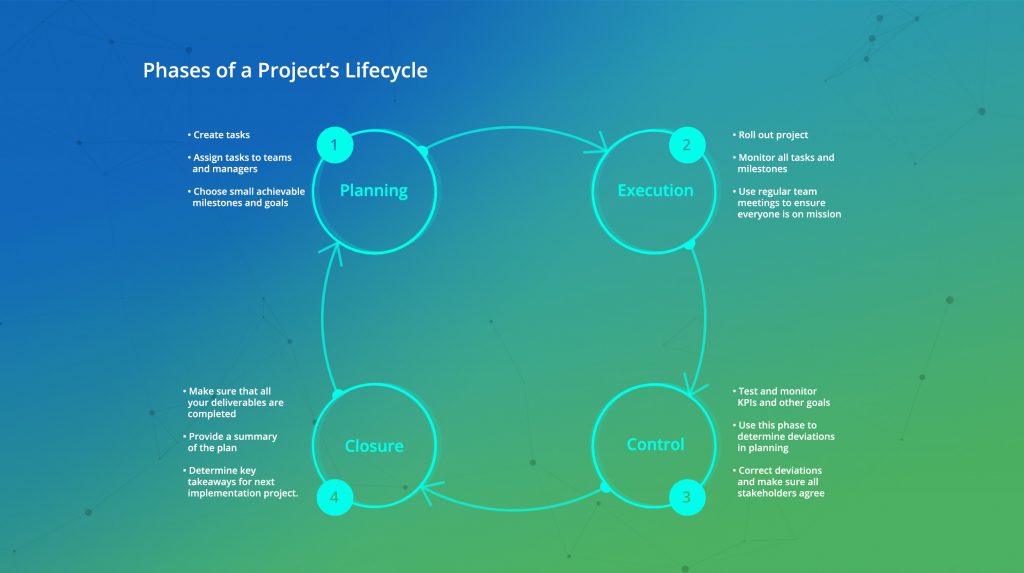What Are the Phases of a Project’s Life Cycle?
July 25th, 2019 (Updated 06/20/2023) | 5 min. read
By Tolu Oke
In the digital age, it is crucial that you are open to change, especially if it leads to your company having the competitive edge when it comes to pricing management.
But changing processes throughout a project life cycle can feel daunting, especially if you’ve worked the same way for twenty-odd years and feel comfortable with the flow you’ve become accustomed to.
The bottom line is, you shouldn’t need to make any changes at all unless there’s a tangible benefit to doing so. While some processes within your company can stand the test of time, others, such as your pricing management system, require digital transformation in order to minimize manual labor costs, provide optimal service to your customers and suppliers and enhance your reputation as market leaders.
If you are working with huge Excel files, paper-based systems or on-premise software, you may be carving a rod out for your own back. Recent digital advances in pricing management now mean you can quickly and easily implement effective processes, cutting manual labor time and enhancing accuracy and speed. It means that every phase of a project life cycle can be managed with greater efficiency.
The Four Phases of a Project Life Cycle
Poor project performance wastes $122 million of every $1 billion invested in projects by companies in the United States. Therefore, having an excellent and robust project management life cycle is crucial, and digital transformation can help you achieve this. The four recommended phrases are as follows:
Phase 1: Planning
In the planning phase, you segment your project into smaller tasks. Each task might be assigned a team or manager, and a schedule should be prepared showing how and when each task will be completed. Creating small, achievable goals maximizes the chances of the project being a success and keeps focus on the overall goal while attending to the smaller details too. Estimating costs is also an important factor in this phase. After all, should budgets be off, the entire project can come crashing to a halt at a later stage, wasting the time and efforts already invested. Finally, you will need to outline a quality plan, detailing quality targets and control measures. Alongside this, you’ll want to draft an acceptance plan, bullet pointing the criteria that will need to be achieved to gain customer acceptance. Only then will the project be ready for the second phase – execution.
Phase 2: Execution
The execution phase is the most crucial phase of the project but can only be undertaken once it is properly planned, otherwise you will have less chance of a successful outcome. Simply put, this is the phase where you roll out the project and implement the agreed processes. It is important to continually monitor this phase, constantly evaluating its efficacy and ensuring it remains on track with the overall project goals. The people or teams assigned to each task will begin their work, feeding back to the project manager regularly. Team meetings are a great way of keeping this phase controlled and well communicated. A project plan should be updated by all subgroups and fed back to stakeholders. Sometimes, the plan needs to be altered at this stage. It is crucial that all members of each team are kept aware of any changes that take place. It is also important to monitor costs and spending, evaluating budgets as you go.

Phase 3: Control
Project testing and monitoring make up the control phase. This is done to ensure that the work being executed is meeting expectation. Project acceptance by the client is the main objective here. Deviations might be picked up on in this phase, or it could be that the client requests a change or has changed the brief slightly since the planning stage. Once changes and adjustments are made, the client will then approve the project and the next phase of the life cycle can begin – closure.
Phase 4: Closure
The closure phase can also be referred to as the completion phase and marks the end of the project management life cycle. The final deliverables are ready to be presented to the client. Some other tasks that might occur during this phase are the handing over of documentation, terminating supplier contracts and communicating with stakeholders. It is always important to learn lessons from projects so that future projects can be even more effective, so a closing team meeting can be beneficial during this stage too.
Given the complexity of the tasks involved in any project life cycle, it is important that it is executed with speed, accuracy and minimal errors. After all, a manual error at any point of the life cycle can totally collapse the entire project. Sometimes, these errors are noticed too late, resulting in wasted time and money for all involved.
Digital transformation serves several benefits when it comes to your project life cycles.
- It makes all processes at all stages faster without compromising quality.
- There is better flexibility and adaptability, especially in cases where change midway through a cycle is necessary.
- Mistakes are minimized.
- Upgrading is easy, unlike with some older software which can be costly or impossible to properly update.
- Your customers, suppliers and stakeholders will be satisfied, helping to strengthen relationships.
- There is better alignment between everyone involved in the project, as well as the processes within it.
While it can feel daunting to introduce digital transformation to pricing management, it can be much easier than you may have anticipated.
Pricefx can be implemented with minimal downtime and has the ability to adjust and align with the processes you currently have in place, making the transition to digital pricing management a smooth one. Find out more information about how Pricefx can help you here.